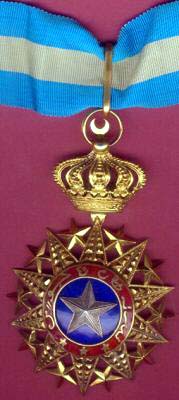Order of Nichan el-Anouar
The order of Nichan el-Anouar ( fr. Ordre du Nichan el-Anouar ) was founded in October 1887 by the Sultan of Tadjoura Hamed ben Mohamed as a military and civil merit order. By decrees of the French President Félix Faure on May 10 and 23, 1896, the order was incorporated into the French system of orders as a so-called colonial order.
With the foundation of the French National Order of Merit, the award of the order Nichan el-Anouar was discontinued in 1963.
Order classes
The order consists of five classes
After the acceptance into the French order system, conditions were attached to the award of the order. According to this, the person to be honored had to be able to prove a period of at least three years of service in the French colonies on the east coast of Africa and Central Africa , or had to have made special contributions to these colonies in metropolitan France.
On July 14, 1933, the statutes were changed so that to be awarded the age of 29 and a minimum of nine years of colonial service had to be proven.
Order decoration
The sign of the order is a ten-pointed star that hangs on a royal crown. Small golden five-pointed stars can be seen between the star arms . In the blue enamelled medallion, which is surrounded by a red enamelled ring with the Arabic inscription Nichan el-Anouar , a silver five-pointed star.
Carrying method
The way of wearing the order was based on the Legion of Honor . The grand cross was worn on a sash from the right shoulder to the left hip and with an enlarged medal as a breast star on the left side of the chest. Grand officers decorated the award on the ribbon on the left side of the chest with a rosette and a breast star on the right side of the chest. Commanders wore the medal of neck . Officers and knights wore the award on the ribbon on the left side of the chest. Officers additionally with a rosette on the ribbon.
The ribbon was originally red with a black central and a blue and white border. Since the resemblance to the red ribbon of the Legion of Honor was too great, it was decided on December 5, 1899 to use a blue ribbon with a wide white central stripe.
Known porters
- Théophile Tellier (1872–1955), Colonial Officer - Officer's Cross (1904)
literature
- André Souyris-Rolland: Guide des Ordres Civil Français et Étrangers, des Médailles d'Honneur et des Médailles des Sociétés. Paris 1979.
- André Damien: Les Ordres de Chevalerie et les Décorations. Éditions Mémoire et Documents, ISBN 2-914611-05-6 .
